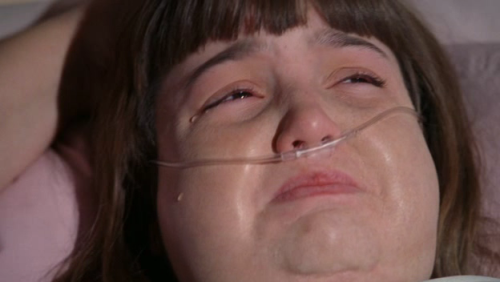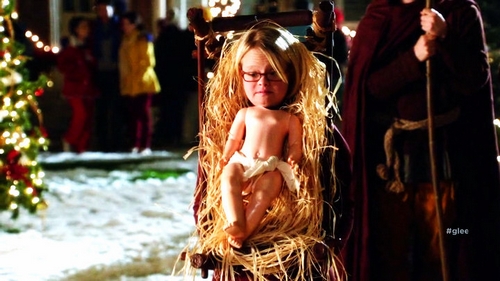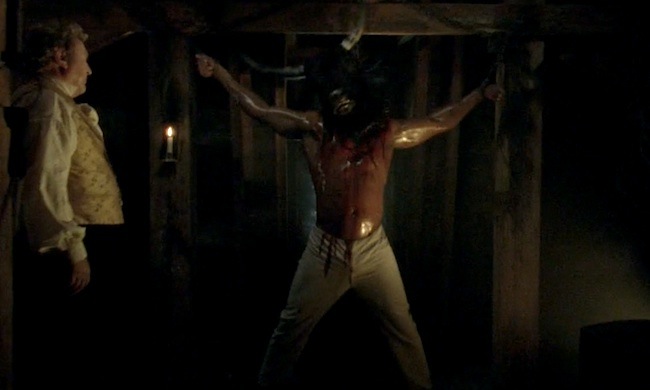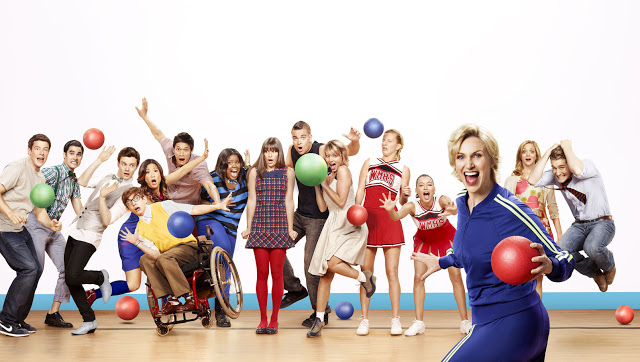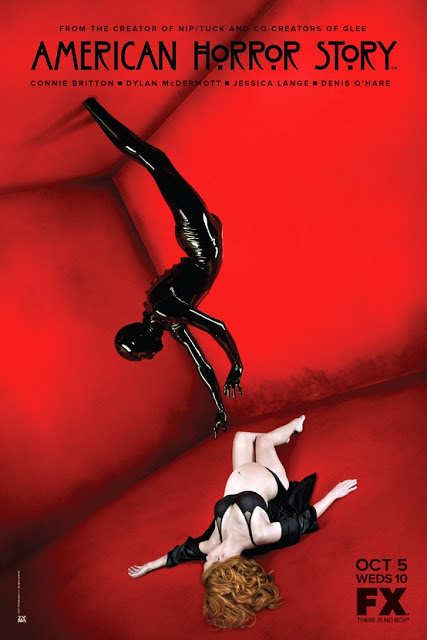Written by Elizabeth Kiy as part of our theme week on Fatphobia and Fat Positivity.
Most medical dramas draw from a common well of plots. There’s the amnesiac, the guy who wakes up from a coma after 10 years, the deadbeat dad who wants a transplant from his daughter, and the 600-pound (or thereabouts) man who has to be cut out of his house.
Of course, this man is treated like a monster, the rare patient not worthy of sympathy because it is assumed his condition is entirely his fault, and he has chosen to be unhealthy. Fat bodies on TV as well as in Western culture as seen as shameful and disgusting. The 600-pound man on TV is treated as a medical oddity and a living freakshow that doctors within the program and viewers at home are invited to gawk at, assured that as uncomfortable we may be with our own bodies, at least we’re not that.
On House, the 600-pound man is further Othered by the assumption that he is dead when he is first discovered. When he wakes up, groaning and thrashing around, unsure what is happening to him, he is doubly monstrous, both fat and “undead.”

Fat bodies also have a curious position in medical drama, reflecting the fatphobia existing within the medical profession. Doctors tend to assume weight always a cause rather than a symptom and overweight patients are either lazy, uneducated, or poor. The wealthier we are, the more opportunity we have to strive for thinness. As a class, doctors are incredibly privileged, both highly educated and wealthy, they have the privilege of deciding to be thin that many of their patients do not.
The appearance of the 600-pound man compounds on the subtle fatphobia within the medium of television, as all the lead actors, and so all the TV doctors, are attractive and fit.

Though Grey’s Anatomy stands out from the pack with its inclusion of several lead characters who are a larger size, and are treated as positive figures worthy of love, many episodes also contain fat jokes. In several episodes, Dr. Lexie Grey (Chyler Leigh), one of the thinner characters, is experiencing extreme stress, and her way of coping with it is to binge eat junk food. When she gains a small amount of weight, other characters mock her for it, but it is never treated as a serious problem; the stress goes away and Lexi continues to be thin. The plot line was intended as an in-joke about the actress’s weight gain during her pregnancy, but it stinks of thin privilege that anyone though this was light-hearted comedy.
Fatphobia is the one acceptable prejudice on TV. Characters we are meant to continue to like and sympathize with can be exposed as fatphobic without thought of consequences, such as Dr. Chase (Jesse Spencer), House’s resident heartthrob. In the episode, Heavy, when an overweight 10-year-old girl is admitted to the hospital after having a heart attack during gym class, Chase, usually especially kind to kid patients, is incredibly cruel to her. He laughs at her and suggests that if she wants her health problems to go away, she should “stop shoving her face with food.” He also dismisses her symptoms of fatigue, muscle pain, and difficulty concentrating as due to clinical depression over her weight. The girl, Jessica, has been bullied and is isolated at school and has been abusing exercise and diet pills and the episode is very uncomfortable to watch, even triggering.

When Chase’s coworker, Dr. Cameron (Jennifer Morrison) attempts to defend Jessica, he laughs at her as well, saying she is fatphobic as well, because she does everything she can to stay thin. She gets by on thin privilege and enjoys the benefits of others finding her attractive. Later in the episode, we learn that Chase himself used to be overweight and because he was able to lose weight and keep it off, believes everyone who can’t is ignorant and lazy. He continues to blame Jessica’s health problems on her weight, refusing to see that it might be a symptom.
However, the show goes on to suggest that Jessica is the rare fat person who is worthy of our sympathy because her weight is not her fault. She maintains a healthy diet and regularly exercises, but is unable to lose any weight. Because of this she is not a “real” fat person so negative stereotypes do not apply. It turns out that she has a pituitary tumor that was causing her to gain weight and the episode ends with a final triumphant shot of Jessica thin and smiling. This shot is notable as House episodes rarely ended with the “cured” patients returning to the hospital or of showing their recovery, its inclusion suggests that the writers though we needed to be reassured that Jessica eventually gets thin.

In House’s 600-pound man episode, attempts are also made to deny him proper medical care as fat jokes are made about him, diagnoses are ruled out without proper consideration because of his weight and he is initially barred from their MRI machine because it is not strong enough to support him.
Grey’s Anatomy’s take on the same plot is handled with a bit more tact. The doctors, most of whom are interns and residents beginning their careers, are given a lecture about proper behavior and sensitivity before they interact with the patient and are warned that anyone who make rude comments will be taken off the case. This rule is strictly enforced, even when the doctors do not feel they’ve done anything wrong. Many of the doctors we are meant to continue to like make fat jokes throughout the episode, but are painted as being young and immature. We are meant to like them, but not support what they are doing.

Yet, the patient frequently makes jokes at his own expense and urges the doctors to lighten up, refusing to admit the seriousness of his condition. What gets through to him is the doctors joining him in making fat jokes. With this in mind, it’s difficult to tell whether the show is saying we need to be more sensitive or less sensitive about weight.
The show Nip/Tuck, focusing on plastic surgeons, already comes from a more superficial place than the typical medical drama, but contains some startling examples of fatphobia. Doctors frequently mock fat patients when they are off-screen and discuss acquaintances who need surgery to even be considered normal looking. In one early plot line, an overweight woman who wants to be thin for her high school reunion to show up her tormenters, is denied liposuction because she is also bipolar, commits suicide. This woman’s sad story is not revisited after the single episode and characters continue to exhibit incredible thin privilege. In another episode, anti-hero Dr. Troy (Julian McMahon) has sex with sex-positive, upbeat overweight woman and finds it incredibly enjoyable. He is horrified and after some soul searching, brutally drags her down into self-hatred, making her feel as unhealthy and unattractive as he believes she should feel.
Though it’s a comedy, The Mindy Project also has a conflicted relationship with fatphobia. Protagonist Dr. Mindy Lahiri (Mindy Kaling) is a bright, bubbly woman who happens to be a bit larger that most actresses on TV, and for the most part she is comfortable with her body. She sees herself as sexy and attractive and is treated as such. Still, she refuses to tell people how much she weighs, describes herself as “anorexic” and as wearing an extra small. Mindy though, is not a character who is meant to be perfect or even entirely likeable. She is instead, an exaggerated example of how many of us feel about our bodies.

If I were to chose a TV doctor, I think Mindy would make me feel the best about my body. She reserves her fatphobia for herself and tells her patients they look awesome.
Elizabeth Kiy is a Canadian writer and journalist living in Toronto, Ontario.
